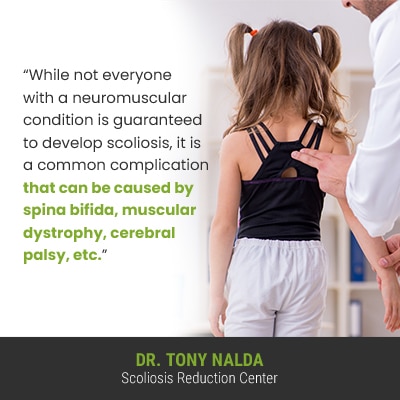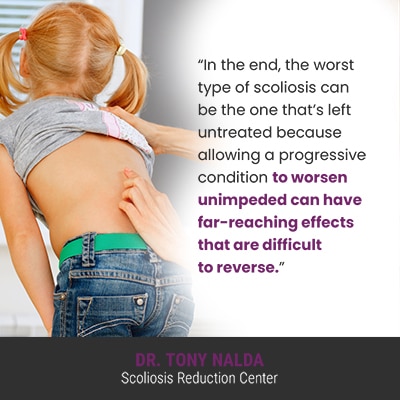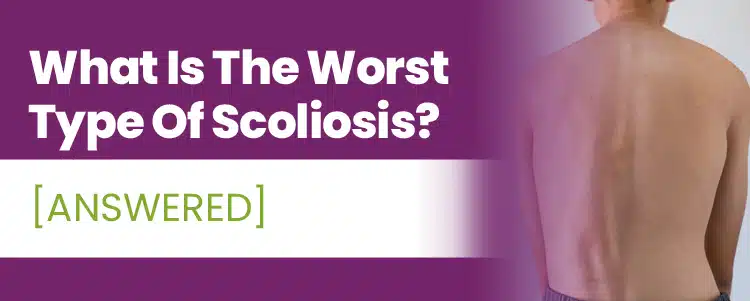Scoliosis can affect all ages, ranges widely in severity, and has different condition types. The most common type of scoliosis is classified as idiopathic, and the remaining atypical types are associated with known causes. Continue reading to learn how typical and atypical cases of scoliosis differ.
Part of the reason scoliosis is so often deemed a complex condition to treat is because it has different types; type is determined by causation. An atypical type of scoliosis that can be very severe is neuromuscular scoliosis.
To understand the different types of scoliosis, some other condition characteristics have to be explored, so let’s start by defining the condition.
What is Scoliosis?
Scoliosis is a highly-prevalent progressive spinal condition involving the development of an unnatural sideways spinal curve, and in addition to bending unnaturally to the side, a scoliotic curve also twists, making scoliosis a complex 3-dimensional spinal condition.
In order to be diagnosed as scoliosis, a scoliotic curve also has to be of a minimum size: Cobb angle measurement of at least 10 degrees.
A patient’s Cobb angle is determined during X-ray by drawing lines from the curve’s most-tilted vertebrae, at its apex, and the resulting angle is expressed in degrees:
- Mild scoliosis: Cobb angle measurement of between 10 and 25 degrees
- Moderate scoliosis: Cobb angle measurement of between 25 and 40 degrees
- Severe scoliosis: Cobb angle measurement of 40+ degrees
- Very-severe scoliosis: Cobb angle measurement of 80+ degrees
When the spine’s natural and healthy curves are in place, its vertebrae (bones) are aligned in a straight and neutral position, but if an unnatural spinal curve develops, some vertebrae have become unnaturally tilted, shifting them out of alignment with the rest of the spine.
A spine that’s not aligned is not going to be able to function as it was designed, and this disrupts the biomechanics of the entire spine, not just the section with the scoliosis.
The development of a scoliotic curve introduces a lot of uneven forces to the body, and those forces can disrupt its overall symmetry and cause a number of issues that aren’t solely isolated to the back.
Scoliosis is Progressive
The more severe a condition, the more likely it is that its effects are going to be noticeable, and in children, the main symptom of scoliosis is postural deviation, and in adults, it’s pain.
So the worst type of scoliosis in terms of severity is very-severe scoliosis with a Cobb angle measurement of 80+ degrees, and another factor that contributes to pain and severity is a patient’s angle of trunk rotation; the more twisted the spine is, the more noticeable the condition’s effects tend to be, and the more painful it’s likely to be.
And as a progressive condition, where a scoliosis is at the time of diagnosis doesn’t necessarily mean that’s where it will stay, not without the help of proactive treatment that works towards counteracting its progressive nature.
Scoliosis progressing means the size of the unnatural spinal curve is increasing, as are the condition’s uneven forces, and their effects.
In addition to condition severity, the worst type of scoliosis is one that’s caused by the presence of a larger medical condition.
Which Type of Scoliosis is the Worst?
Which type of scoliosis is the worst is a question I’m often asked, and while this is a difficult question to answer because there are a number of variables that affect quality of life, condition type is important because it’s determined by causation.
As mentioned, the most common type of scoliosis is idiopathic, meaning not clearly associated with a single-known cause, and this type accounts for approximately 80-percent of known diagnosed cases; the remaining 20 percent are associated with known causes and are considered atypical.
Neuromuscular scoliosis, degenerative scoliosis, and congenital scoliosis are atypical condition types with unique treatment needs.
Degenerative scoliosis is caused by natural age-related spinal degeneration, and congenital scoliosis is caused by a malformed spine that develops in utero, and these can be serious types, but neuromuscular scoliosis is caused by the presence of a larger neuromuscular condition, so these types of cases are often among my most challenging to treat.
Neuromuscular Scoliosis

While not everyone with a neuromuscular condition is guaranteed to develop scoliosis, it is a common complication that can be caused by spina bifida, muscular dystrophy, cerebral palsy, etc.
In cases of neuromuscular scoliosis, the larger neuromuscular condition is causing a disconnect between the brain and the muscles and connective tissues that support the spine, and without that crucial support, the spine can’t maintain its natural and healthy spinal curves.
In typical cases of idiopathic scoliosis, the scoliotic curve bends to the right, away from the heart, but in atypical cases with an underlying pathology, the curve can bend to the left, towards the heart, and this is a red flag that it is a severe type; with these patients, I can’t offer them the same types of prognoses that I can with typical cases.
The larger underlying neuromuscular condition complicates the treatment process as it has to be the focus of treatment.
Now, regardless of type and/or severity level, the best time to start scoliosis treatment is always now; while there are no treatment guarantees, even in atypical cases, improvements that can impact overall quality of life can always be worked towards.
Scoliosis Treatment Options
There are two main scoliosis treatment approaches, and it’s important to understand the difference because each offers patients a different potential outcome; traditional treatment involves watching and waiting and a surgical response, while modern conservative treatment involves proactive chiropractic-centered treatment.
Traditional treatment doesn’t have a strategy for treating scoliosis while mild so commonly tells patients with mild scoliosis that merely watching and waiting is enough, but to me, this is wasting valuable treatment time.
Traditional treatment only applies bracing in the moderate stage of progression, but traditional bracing has changed little over its inception in the seventies and is associated with a number of shortfalls.
When/if patients undergoing traditional treatment progress to severe, they become surgical candidates and are funneled towards spinal fusion, and I say funneled because little was done beforehand to prevent progressing to that point; this is where proactive treatment comes in, and particularly with early detection and intervention, scoliosis can be highly treatable.
Here at the Scoliosis Reduction Center®, I treat patients non-surgically with a conservative chiropractic-centered treatment approach that starts treatment as close to the time of diagnosis as possible; as a progressive condition, this is when it’s going to be at its mildest and most responsive.
As scoliosis progresses, the spine gets more rigid, making it less responsive to chiropractic treatment, and making it challenging for some patients to perform key therapeutic exercises as part of treatment.

Here at the Center, I integrate condition-specific chiropractic care, physical therapy, corrective bracing, and rehabilitation so conditions can be impacted on every level.
First and foremost, as a structural condition, scoliosis has to be impacted structurally in the form of a curvature reduction achieved through a series of chiropractic techniques and manual adjustments.
Once structural results are seen, I can shift the focus to increasing core strength through physical therapy so the spine’s surrounding muscles can provide it with optimal support.
In the end, the worst type of scoliosis can be the one that’s left untreated because allowing a progressive condition to worsen unimpeded can have far-reaching effects that are difficult to reverse.
Conclusion
When it comes to the worst type of scoliosis, this can reference condition severity, and scoliosis can range from mild to moderate and severe to very severe, or it can reference an atypical type with unique treatment needs like neuromuscular scoliosis.
Scoliosis severity is an important condition variable that shapes the design of treatment plans, and the goal of conservative treatment is to reduce the size of a scoliotic curve on a structural level to achieve corrective results.
Watching and waiting is part of traditional treatment, but while monitoring, a young patient can have a significant growth spurt, and as growth triggers progression, this can mean the condition getting worse quickly, so why not work proactively to prevent that from happening?
It’s more effective to treat scoliosis while mild than it is to attempt to reverse the condition’s effects once they become severe.
Again, regardless of condition type or severity, the best time to start scoliosis treatment is always now, so don’t hesitate to reach out for guidance and support that can help put you on the road to a better quality of life.




